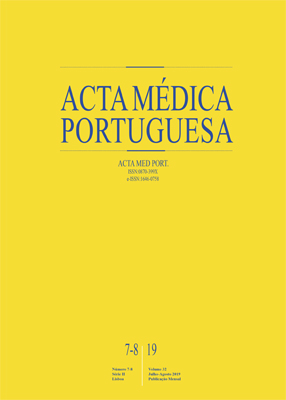Metabolic Bone Disease of Prematurity in Very Low Birthweight Infants: Retrospective Observational Study
DOI:
https://doi.org/10.20344/amp.10994Keywords:
Bone Diseases, Metabolic, Infant, Extremely Low Birth Weight, Premature, Diseases, Nutritional StatusAbstract
Introduction: Metabolic bone disease of prematurity consists in a decrease of bone matrix mineral content, in comparison with the level expected for gestational age. Screening of this condition is based on serum alkaline phosphatase and phosphate levels. The aim of this study is to evaluate the prevalence of metabolic bone disease of prematurity, to assess the aspects associated with a higher risk of this disease and to describe the growth of newborns with birth weight below 1500 g and metabolic bone disease of prematurity.
Material and Methods: Observational, retrospective, multicenter and descriptive study in three neonatal intensive care units in Portugal, from May 1st 2016 to April 30th 2017. A convenience sample of very low birthweight newborns was obtained. Demographic, clinical, and laboratory variables were described in newborns with and without metabolic bone disease of prematurity.
Results: A total of 53 newborns were included in this study: 30 males, 16 with gestational age ≤ 28 weeks. Five cases of metabolic bone disease of prematurity were diagnosed. In this group, the majority of patients was male and presented a lower gestational age and birth weight, in comparison with the group without metabolic bone disease of prematurity. The average duration of parenteral nutrition was higher in newborns with metabolic bone disease of prematurity and the calcium/phosphate ratio was lower than the recommended values. Growth was similar in both groups. No patient with metabolic bone disease of prematurity underwent physical rehabilitation.
Discussion: The prevalence of metabolic bone disease of prematurity was 9.43%, which is lower than what is described in the literature. However, only 50% of newborns completed the screening according to the recommendations. The main risk factors identified concur with the literature.
Conclusion: Metabolic bone disease of prematurity is a frequent but underdiagnosed comorbidity in very low birthweight newborns. It is essential to screen newborns at risk for this condition, using biochemical markers, as well as structure nutritional interventions and physical stimulation in order to avoid short and long-term consequences of this disease.
Downloads
Downloads
Published
How to Cite
Issue
Section
License
All the articles published in the AMP are open access and comply with the requirements of funding agencies or academic institutions. The AMP is governed by the terms of the Creative Commons ‘Attribution – Non-Commercial Use - (CC-BY-NC)’ license, regarding the use by third parties.
It is the author’s responsibility to obtain approval for the reproduction of figures, tables, etc. from other publications.
Upon acceptance of an article for publication, the authors will be asked to complete the ICMJE “Copyright Liability and Copyright Sharing Statement “(http://www.actamedicaportuguesa.com/info/AMP-NormasPublicacao.pdf) and the “Declaration of Potential Conflicts of Interest” (http:// www.icmje.org/conflicts-of-interest). An e-mail will be sent to the corresponding author to acknowledge receipt of the manuscript.
After publication, the authors are authorised to make their articles available in repositories of their institutions of origin, as long as they always mention where they were published and according to the Creative Commons license.









